Operating purified water filling equipment safely is crucial to maintain product quality and ensure workplace safety. Whether you're a seasoned operator or new to the task, adhering to safety guidelines is paramount. This guide outlines essential practices to follow when using purified water filling equipment.
Safety Guidelines for Purified Water Filling Equipment
Proper operation of purified water filling equipment involves several key safety measures to prevent accidents and maintain efficiency. Regular maintenance, thorough training, and adherence to protocols are essential for smooth operations. Operators must wear appropriate protective gear, including gloves and safety goggles, to minimize risks associated with handling equipment and chemicals.

Equipment Inspection and Maintenance
Regular inspection and maintenance of the equipment are critical to ensuring its proper functioning. Before each use, inspect all components for wear, leaks, or any signs of damage. Replace worn-out parts promptly to prevent operational failures or safety hazards. Lubricate moving parts as recommended by the manufacturer to maintain smooth operation and extend equipment lifespan.
Operational Procedures
When operating purified water filling equipment, follow standard operating procedures (SOPs) meticulously. Start by verifying that the equipment is clean and sanitized according to hygiene standards. Ensure that all valves are properly aligned and securely fastened before starting the filling process. Monitor the equipment closely during operation to detect any abnormalities or malfunctions promptly.
Chemical Handling and Storage
Proper handling and storage of chemicals used in the purification process are crucial for operator safety and product quality. Store chemicals in designated areas away from direct sunlight and heat sources. Follow safety data sheets (SDS) provided by chemical suppliers to understand proper handling procedures, including wearing appropriate protective clothing and using ventilation when necessary.
Conclusion
Operating purified water filling equipment safely requires attention to detail and adherence to established safety protocols. By regularly inspecting and maintaining equipment, following operational procedures meticulously, and handling chemicals responsibly, operators can contribute to a safe and efficient workplace. Prioritizing safety not only protects personnel but also ensures the integrity of the purified water produced. Incorporate these guidelines into your operations to enhance safety and maintain high standards of product quality.






























